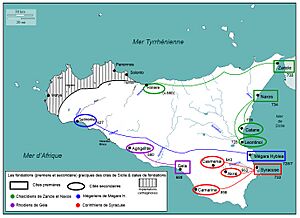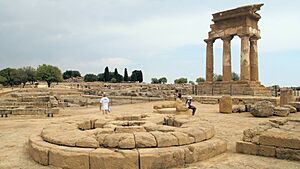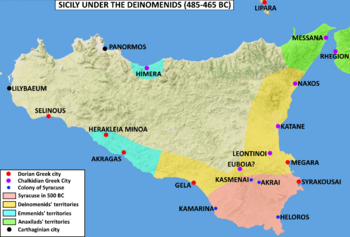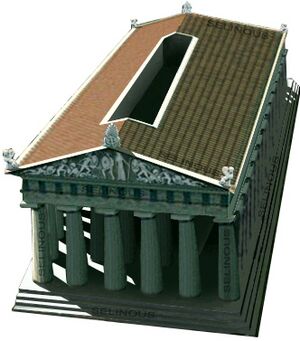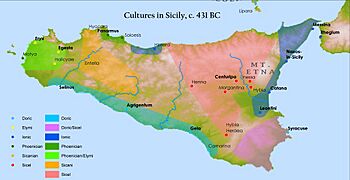History of Greek Sicily facts for kids
The History of Greek Sicily began when the first Greek settlements were started around the middle of the 8th century BC. The Greeks who lived in Sicily were called Siceliotes.
Over the next few centuries, there were many fights between these Greek city-states. Around 276 BC, Pyrrhus of Epirus managed to take over almost the entire island, except for Lilybaeum, which was controlled by the Carthaginians. After the First Punic War in 241 BC, the island was taken over by the Romans.
Greek Cities in Sicily
The first Greek settlements were built in eastern Sicily in the 8th century BC. Greeks from Chalcis founded cities like Zancle, Naxos, Leontinoi, and Katane. In the southeast, people from Corinth started Syracuse, and those from Megara founded Megara Hyblaea. On the western coast, people from Crete and Rhodes started Gela in 689 BC. This marked the end of the first wave of Greek colonization in Sicily.
These Greek cities in Sicily were called apoikìai. This means they were new cities that were separate from their original home cities, and each was led by a founder called an oikistes.
People of Ancient Sicily
Greeks and Other Islanders
The original people living on the island were the Sicani, the Siculi, and the Elimi. There were also small trading posts set up by the Phoenicians in the west of the island. As the Greek settlements grew, they often clashed with the Phoenicians. This led to many wars between them. Later, as Rome became powerful, these conflicts continued as the Roman-Punic wars.
The Greeks wanted to settle and control the island. The Phoenicians, however, mostly wanted small trading spots and didn't aim for full control. This meant that the Greeks and the Siculi often had conflicts, as the Greeks were the colonizers. The Phoenicians often got involved as a third party, sometimes helping weaker Greek groups against stronger ones, or teaming up with the Siculi against Greek settlements. They did whatever helped their trade interests the most.
In the end, many Greeks settled permanently in Sicily. Carthaginian settlements, however, were not as lasting.
History of Greek Sicily
How Greek Colonies Started
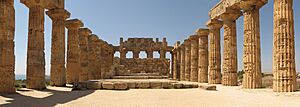
Ancient stories identified Sicily with "Thrinacia," the island of the sun god Helios' cattle. It was later called "Trinakria," meaning "island with three headlands," because of its shape.
The historian Thucydides wrote that the first Greek colonies were founded by noble families. This happened after internal struggles following the Trojan War. However, the first places chosen for settlement show a focus on trade. Cities like Messina, Naxos, Reggio, Catania, and Syracuse were all important ports. They were located on key trade routes of that time, allowing the Greeks to control them.
The earliest Greek colonies in Sicily were all on the east coast. This shows how important the trade route through the Straits of Messina was. The main cities from which the Greek colonists came often gave their names to the new cities. Once these colonies became strong, they sometimes created smaller settlements. These smaller places were often for military reasons or to help with trade. For example, Akrai and Casmene probably started as military outposts for Syracuse.
The First Tyrants
The 6th century BC was a time of growth and wealth in Sicily. But it also brought conflicts within the colonies and with the local people. Some powerful individuals took advantage of this. They gained power through harsh methods and by expanding their control. In 570 BC, Phalaris became the ruler (tyrant) of Akragas. Later, Cleander became tyrant of Gela in 505 BC, followed by his brother Hippocrates.
Hippocrates wanted to secure his power. He conquered much of eastern Sicily, taking over Zancle (Messina), Naxos, and Leontini. He put rulers loyal to him in these cities. However, he couldn't conquer Syracuse. Hippocrates then focused his army on Ibla, but he died there. Gelon took over from him in 491 or 490 BC. Six years later, Gelon conquered Syracuse without a fight (485 or 484 BC). He made Syracuse his capital and became its tyrant. He left his brother Hiero in charge of Gela.
Gelon's rise to power made the Greek presence in Sicily much stronger. He saw the increasing numbers of Siculi and Sicani as a threat. He fought many battles to deal with this. He turned Syracuse into a powerful city with a strong army and navy. He brought people from Gela and some conquered Megareans to repopulate Syracuse. In just ten years, Gelon became the richest and most powerful person in the Greek world. He formed an alliance with Theron of Acragas. Together, they controlled most of Greek-speaking Sicily, except for Selinunte and Messina.
Terillus of Himera and Anaxilas asked Carthage for help. But Gelon and Teron gathered all the Greek forces in Sicily for a major battle at Himera in 480 BC. They defeated and killed Hamilcar, burned his ships, and sold the captured Carthaginian soldiers into slavery. The peace treaty that followed made Carthage pay a large amount of money. It also forced them to stop human sacrifice. When Gelon died in 476 BC, his brother Hiero took over. That same year, Hiero conquered Catania and Naxos. He moved their people to Leontini and renamed Catania 'Aitna'. He put his son Deinomenes in charge and brought new settlers from the Peloponnesus. In 474 BC, his fleet defeated an Etruscan fleet near Cumae. This might have been to stop Etruscan expansion or to help Cumae.
A Time of Democracy (466-405 BC)
According to the historian Diodorus Siculus, Trasibulus (Hiero's successor in Syracuse) and Thrasydaeus of Akragas were very cruel rulers. Their harshness seems to have caused rebellions that ended the first period of tyrants among the Greek colonies in Sicily. However, Aristotle believed their downfall was mainly due to fights between powerful families. Trasideus was the first to fall. He was defeated by a group of Syracusan rebels, Siculan troops, and soldiers from Akragas, Gela, Selinunte, and Himera.
Only Deinomenes remained in power in Aitna. But a group of Siculi and Syracusans forced its people to flee to the nearby hills. Catania then returned to its old name. It was repopulated with people who had been exiled under Hiero, and with settlers from Syracuse and the Siculi. Messina also became free from the rule of Anaxilas' sons around the same time.
In 452 BC, a Hellenized Siculan named Ducetius led a large Siculan revolt. He had fought with the Syracusans before. Starting from his hometown of Mineo, he destroyed Inessa-Etna and Morgantina. He then founded his own settlements in important places to control the land. These included Palikè. Around 450 BC, the Syracusans heavily defeated him. He was forced to go into exile in Corinth. But he soon returned to Sicily with a small group of Greeks. He founded Kale Akte, where he stayed until his death in 440 BC. In the years that followed, Syracuse took back almost all the lands he had taken from Greek control.
The Peloponnesian War had started in mainland Greece in 431 BC. This war heavily involved the colonies in Sicily. In 427 BC, groups of Siculi got involved again. This time, it was in a war between Leontini and Syracuse. This conflict also brought in Catania, Naxos, and Camarina on Leontini's side. Himera and Gela joined Syracuse's side. After three years, in 424 BC, a peace treaty was signed. The Syracusan Hermocrates helped arrange this. He wanted to focus on the Athenian troops who had landed on the island. As a result of the treaty, the Athenians left. In 422 BC, a civil war in Leontini gave Syracuse a new reason to get involved. The city was destroyed, and the winning oligarchs moved to Syracuse.
The conflict also spread to western Sicily. In 416 BC, Selinunte (with help from Syracuse) declared war on Segesta. Segesta then asked Athens for help after Carthage refused. In 415 BC, Athens sent Alcibiades with a large fleet of 250 ships and 25,000 men to help them. But this Sicilian expedition ended badly. Later help in 414 BC and 413 BC under Demosthenes still couldn't defeat the forces that had gathered at Syracuse. By the end of 413 BC, the Athenians were completely defeated. 7,000 of their men were captured and sent to stone quarries, where most died. The rest were sold into slavery. Demosthenes and Nicias were put on trial. Syracuse celebrated its victory. However, this didn't bring peace inside the city. Its government was led by one of its generals, Diocles of Syracuse. He made many reforms, similar to those in Athens, and created a new set of laws. This policy was helped by Hermocrates being away, commanding a fleet sent to help Sparta.
In 410 BC, Selinunte attacked Segesta. A small group of Carthaginian soldiers came to help Segesta. The next year, Hannibal Mago landed with another army. He completely destroyed Selinunte and killed its people. He then marched on Himera, where he met the Syracusan army under Diocles. After heavy losses, the Syracusans retreated. The people of Himera also fled, but half of them were killed. Hannibal quickly returned to Carthage and sent his army home. Meanwhile, Hermocrates had been removed from the Aegean fleet. He returned with five ships and a small army of refugees and hired soldiers. With these, he settled in what was left of Selinunte and attacked Carthage's allied cities. Syracuse fell into disorder. Diocles was sent away, and Hermocrates was killed trying to resettle.
In the spring of 406 BC, the Carthaginians returned with a large force. They destroyed Akragas and took its artworks. A young man named Dionysius was made the top commander of Syracuse. Syracuse held out for seven months. Gela and then Kamarina fell. At this point, Dionysius was able to sign a peace treaty. This treaty set the boundaries for Syracuse's and Carthage's areas of control on the island. The Punic, Sicanian, and Elymian cities were left to Carthage. It also made Selinunte, Akragas, Himera, Gela, and Camarina pay tribute to Carthage. They were also forbidden from building city walls. But Leontini, Messina, and the Siculi were freed. Dionysius was left in control of Syracuse. This ended the short period of democracy. The time from 405 BC until the Roman conquest would be shaped by the rulers of Syracuse.
Dionysius I of Syracuse
Dionysius I of Syracuse gained power step by step. He ruled over all of Sicily up to Solunto. He also extended his influence to the bay of Taranto and into Etruscan lands. He attacked and destroyed the port of Pyrgi (now Santa Severa) and looted Cerveteri in 384 BC. As early as 404 BC, he broke Syracuse's treaty with Carthage. He began to take over several Siculan colonies, pushing as far as Enna. He then attacked and destroyed Naxos and conquered Catania, moving its people away. He made his army stronger, using new weapons like catapults. He also built a powerful fleet by cutting down many trees from Mount Etna.
He declared open war on Carthage in 398 BC. Erice surrendered, and after a year-long siege, Motia was destroyed, and its people were killed. In 396 BC, the Carthaginians returned to Sicily with a large force. They took almost the entire island, destroyed Messina, and threatened Syracuse itself. But a plague forced them to make peace with Dionysius. They paid him a large sum of money and returned to Carthage. Messina was repopulated. Dionysius fought with Carthage again, with mixed results, until his death in 367 BC.
Around 387 BC, Dionysius started building colonies on the Adriatic coast. He wanted to get wheat from the Po valley without it having to pass through Etruscan territory. He also agreed to let his pro-democracy political opponents settle in these new colonies and set up democratic governments there. This led to the founding of cities like Adrìa (now Adria), Ankón (now Ancona), Issa (now Vis), Dimos (now Hvar), Pharos (now Stari Grad), and Tragyrion (now Traù).
Dionysius was followed by his son Dionysius the Younger. But he was not as skilled as his father. He faced opposition from a group led by Dion of Syracuse, his father's brother-in-law. Dion was exiled in 367 BC. Ten years later, he took 1,000 hired soldiers to Minoa to ask for help. He then marched on Syracuse, which quickly opened its gates and welcomed him. This led to ten years of struggles that involved Leontini and other cities. Syracusan control of Sicily became weaker. Syracuse also suffered from a series of murders. Meanwhile, Callipus became tyrant of Catania, and Hicetas became tyrant of Leontini.
Timoleon's Leadership
In 346 BC, Dionysius the Younger returned to Syracuse. However, the records from this time are incomplete. Political disorder created an unstable situation. Iceta, who was exiled to Leontini, asked Corinth for help. Corinth sent a small army led by Timoleon. He landed at Taormina in 344 BC. In six years, he took control of all Sicily and removed all the tyrants. Most of them were killed, except for his friend Andromacus of Taormina. In 339 BC, he defeated the Carthaginians at the river Crimiso. He took a huge amount of treasure. Later that year, old and possibly blind, he retired.
According to historians Diodorus and Plutarch, Timoleon brought democracy back to Syracuse. However, real power stayed with the Council of Six Hundred. Syracuse and Sicily then began a new period of wealth and rebuilding. Cities like Akragas, Gela, Kamarina, Megara Hyblea, Segesta, and Morgantina all thrived again.
The Hellenistic Era (323 BC onwards)
Agathocles' Reign
When Timoleon retired from politics, Sicily soon entered another period of instability. This was mainly due to conflicts between the wealthy ruling class and the common people of Syracuse. Wars broke out between the cities. This prepared the way for the long rule of Agathocles, starting in 317 BC. He played a major role in these wars. The long period of self-rule for cities in mainland Greece and Sicily ended. This was when the Hellenistic monarchies began.
Agathocles took power in Sicily with the help of soldiers from Morgantina and other inland cities. This happened during two days of popular revolts. According to Diodorus Siculus, 4,000 important people were killed, and 6,000 more were sent away. In the end, Agathocles was chosen as the sole commander with full power. Like other popular leaders of this time, he promised to cancel debts and divide land. It seems from the limited records that he kept these promises. According to Polybius, the cruel actions blamed on him were only at the beginning of his rule. They were aimed only at the wealthy ruling class, never the general population.
Sicily began to prosper again. However, Agathocles' first ten years were marked by conflicts with the wealthy rulers of Akragas, Gela, and Messina. These groups were supported by Carthage. In 311 BC, Carthage invaded Sicily again. Agathocles was surrounded in Syracuse. In mid-August 310 BC, he left his brother Antandros to defend the city. He escaped with 14,000 men and 60 ships to invade North Africa. After arriving, he burned his ships. He set up his base in Tunis, directly threatening Carthage itself. Carthage was forced to send some of its forces back from Sicily to defend its homeland. Hamilcar Barca suffered a humiliating defeat. He was captured, tortured, and beheaded. His head was sent to Agathocles in Africa.
However, Agathocles did not have enough troops to attack Carthage. So, he allied himself with Ofella, an old officer of Alexander the Great and governor of Cyrenaica. Ofella had 10,000 elephants and cavalry. Agathocles then murdered Ofella for unknown reasons and took command of these extra forces himself. He took Utica, Hippon Akra, and a major naval force with its shipyards and bases. Still, he could not take Carthage itself. News of revolts in Sicily in 307 BC forced him to return there for a time. He then went back to Africa. But his forces were low, and his troops' morale was low. This led him to ask for peace in 306 BC. The agreement left Carthage with Eraclea Minoa, Termini, Solunto, Selinunte, and Segesta. But it forced Carthage to give up its plans to expand in Sicily.
At this point, Agathocles took the title of king of Sicily, like Hellenistic rulers. But this was mainly for people outside Sicily. His way of ruling in Sicily stayed the same. He then turned his ambitions east towards Italy and the Greek islands. He conquered Lefkada and Corcyra. The latter was given as a gift when he married his daughter to Pyrrhus of Epirus. Agathocles then married for a third time, this time to a daughter of Ptolemy I. During his long rule, Sicily became wealthy, as shown by archaeological findings. He was murdered by a family rival in 289 BC, at age 72. His death quickly led to chaos and power struggles.
One of these power struggles was between the Syracusans and a group of Italian hired soldiers called the Mamertines. To convince the soldiers to leave the city, the Syracusans offered them the port of Messina. The soldiers seized Messina, killing the men and enslaving the women and children. The soldiers then began raiding the area. They also attacked Gela and Camarina. In 282 BC, Phintias, the tyrant of Akragas, took advantage of this. He finally destroyed Gela and moved its people to Licata. He rebuilt Licata in a pure Greek style with a city wall, temples, and a public square. Two years later, Syracuse attacked and defeated Akragas. They raided the area, but this also caused a new Carthaginian invasion.
The Pyrrhic War
At this point, Pyrrhus of Epirus (who had just won a costly victory against the Romans at Taranto) responded to the Sicilian Greek cities' request for help. He landed at Taormina in 278 BC, welcomed by the ruler Tyndarion. His large army and 200 ships successfully dealt with both the Carthaginian and Mamertine threats. But he could not take the Carthaginian stronghold at Lilybaeum. He soon had to return to Italy.
Hiero II's Rule
In 269 BC, Hiero took power in Syracuse. He made a treaty with the Carthaginians and launched a new attack on the Mamertines. However, Carthage was careful not to let Syracuse's power grow too much. So, they stopped Hiero from taking Messina. Hiero's next step was to declare himself king. He remained king until his death in 215 BC. He built a strong palace on Ortygia. He ruled differently from previous kings. From then on, he followed a policy of not expanding his territory. Instead, he focused on trade in the Mediterranean, especially with Ptolemaic Egypt. He believed the Roman Republic would soon become more powerful than Carthage. So, he made a treaty with Rome in 263 BC and stayed loyal to it until he died. This saved his people from the effects of the First Punic War. In fact, for some years, Roman troops had severely damaged cities in western Sicily.
Today
The city of Messina is home to a small group of people who speak Greek. They arrived from the Peloponnese between 1533 and 1534. They were fleeing the expansion of the Ottoman Empire. They were officially recognized in 2012.


